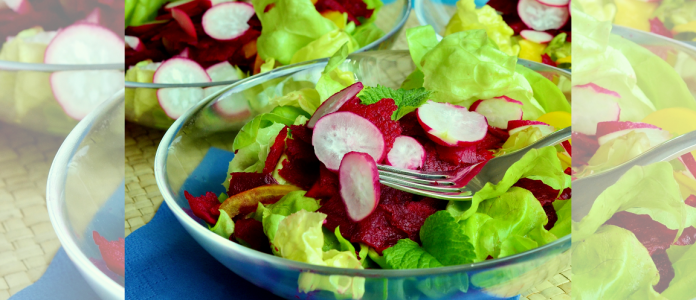For salad lovers, there is nothing nicer than a crisp, fresh salad even in winter and lettuce is the ideal salad base, to which you can add herb leaves, edible flowers and other salad veggies of your choice.
Lettuce contains minerals and vitamins A and C and the greener the leaves the more carotene they contain, which is an antioxidant that protects the body from damaging free radicals.
Starting from seed
Lettuce grows easily from seed. It is best to use seedling trays because the seed is very fine and easy to waste if sown in situ. Do not allow the soil to dry out during germination.
Once the seedlings are big enough to handle (about 10cm high) they can be transplanted. Space plants 30cm apart for ample air circulation, to keep them free of fungus diseases. Handle them carefully and water them carefully as they are still very fragile at this stage.
Growing lettuce growing through winter

The key requirements for growing lettuce through winter are full sun, fertile soil, protection from the cold (even mild frost) with frost cloth, and consistent watering that keeps the soil evenly moist.
Lettuce has shallow roots, so plants need consistent watering. Check at least twice a week and water if the soil is dry down to 5 cm.
Make it a habit to cover lettuce with frost cloth every day, from late afternoon (to trap in the heat) and remove it the next morning. That way, you won’t lose your crop to an unexpected night chill.
Alternatively grow lettuce in plastic covered mini-tunnels, or protect individual plants with a home-made cloche, using a 2-litre plastic cooldrink bottle (base cut off) placed over the plant. Take off the cap so that air can circulate.
Fertilise monthly, preferably with liquid organic feed. Lettuce plants are heavy feeders. Add 1 tsp of Epsom salt to one litre of water or 1 tbsp. to 5litres, for bright green, flavour-full leaves.
Watch out for snails (not a big threat in winter) and protect from birds if necessary. Other than that, lettuce is a very easy, undemanding crop to grow.
Lettuce varieties
Lettuce varieties range from Iceberg types, with crisp heads, to upright Cos lettuce, soft-leaved Butterhead lettuce and loose leaf lettuce, also known as perpetual lettuce.
Each has a different texture and flavour ,so why not grow a variety for the salad bowl? Some are ready for picking sooner like the loose leaf types while the Iceberg/Crisphead varieties have a longer growing cycle.
Try these:

‘Red Sails’ (RAW ) is a beautiful lettuce with bright red tips, shading into light maroon and deepening into green toward the base. The leaves are soft and have a buttery flavour. It can be picked at baby- leaf stage, as larger individual leaves or as a full size lettuce. Space plants 20cm apart and rows also 20cm apart.

Cos ‘Little Gem’ is a dwarf Kirchhoffs variety of Cos type lettuce. This small lettuce is upright growing, with an oblong head of loosely furled green leaves. The leaves are crunchy with a mild, bitter flavour and it is the most nutritious of all lettuce, being high in beta-carotene. It tolerates cold and heat. Plants are ready for harvest within 65 to 70 days.

Kirchhoffs ‘Lettuce Mixed’ combines loose leaf red and green lettuce with varied leaf types. This lettuce can be grown year round and used as baby leaf or full grown lettuce. The leaves can be harvested individually as needed or the plant can be treated as a ‘cut and come again’ lettuce whereby all the leaves are cut at once and new leaves will grow from the centre. The first leaves are ready for picking as mature leaves within 60 to 90 days.

Lettuce Blond De Paris (Kirchhoffs) forms a head but its ruffled deep green leaves are more tender than Iceberg lettuce. The leaves have a sweet flavour and are crisp, delicious in salads and on sandwiches. This lettuce grows well in winter and because it is slow to bolt it can also be planted as a spring crop that can grow into summer.
Best ways to store lettuce

Stored correctly lettuce can last up to two weeks in the crisper drawer of a refrigerator:
- Thoroughly wash loose-leaf varieties with clean water and dry before storing. Roll the leaves in several layers of paper towels or a kitchen towel, then seal in a plastic bag.
- Wrap the leaves of cos lettuce: in paper towel to absorb excess moisture.
- Keep lettuce away from ethylene-emitting produce such as apples, plums, and grapes because ethylene can cause lettuce to wilt.
For more information visit Kirchhoffs and Raw Living.
Article and images supplied by Alice Coetzee






